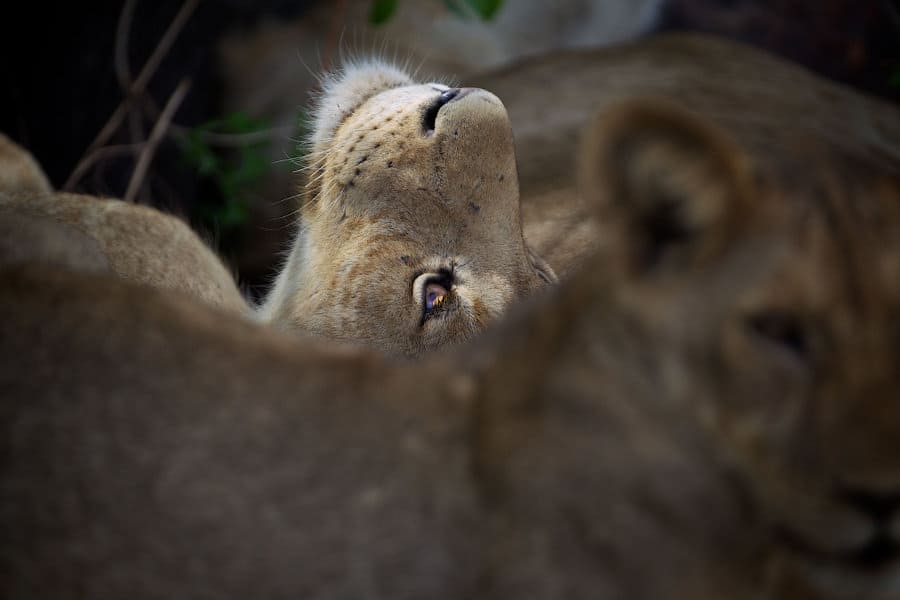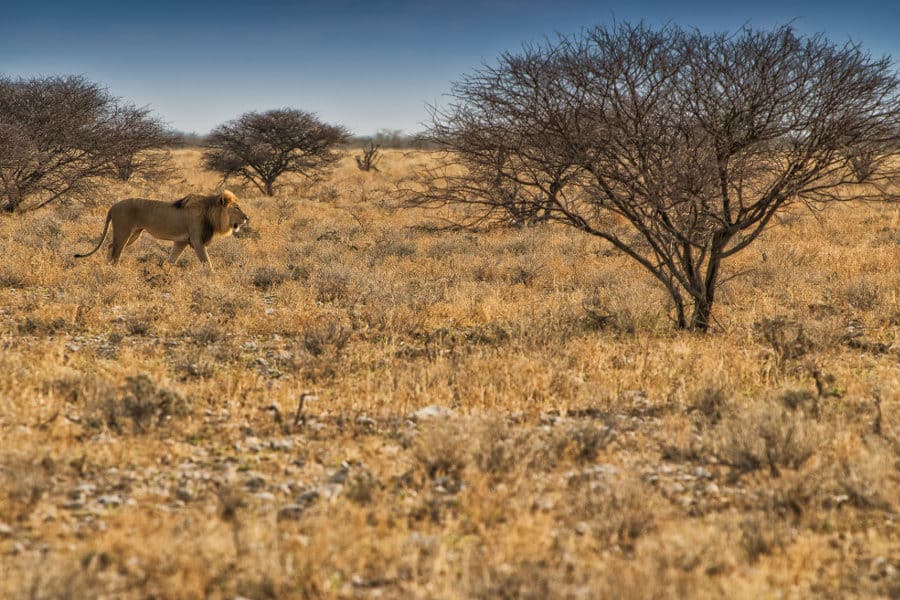Beautiful but deadly, leopard eyes are the last thing many herbivores see.
African leopards are neither as large as a lion, nor as fast as a cheetah, yet they are the most widely distributed big cat, stalking the savanna, deserts, and mountains of the continent.
These ferocious felines are also one of Africa’s most adept hunters. Silent, stealthy, and well-camouflaged, this big cat is rarely spotted before it’s too late.
A leopard’s eyesight is essential to its hunting success. As largely nocturnal predators, leopards’ excellent night vision gives them an advantage over prey. Coupled with a quiet approach, leopards are masters of the ambush attack.
What else makes leopard eyes so well adapted? Read on to find out 10 interesting facts about leopard eyes.
1. What Colour Are Leopards’ Eyes?
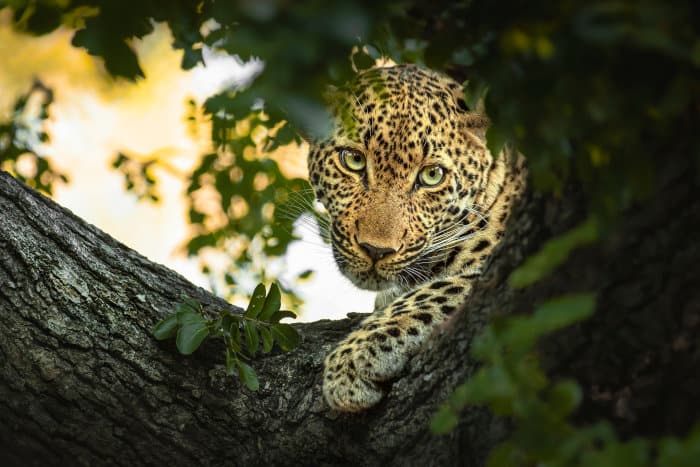
Leopard eyes are usually green to blue in colour, though there’s more variation than many other big cats’ eyes, such as lions. Yellow hues are also common.
While the exact shade varies, leopards’ vibrant eyes stand out against their fur, giving them a distinctive appearance. This contrasts with the cheetah’s amber eyes and is one of many ways to tell cheetahs and leopards apart.
2. Baby Leopard Eyes
It’s hard to see what colour newborn leopards’ eyes are – cubs are born blind and don’t open their eyes for several days.
In these early days, leopard cubs rely on their sense of smell and use kitten-like squeaks to communicate with their mother.
After around 10 days, the baby leopard opens its eyes fully, revealing a pair of beautiful bright blue eyes. These will usually change colour as the leopard grows up.
3. Leopards Have Round Pupils
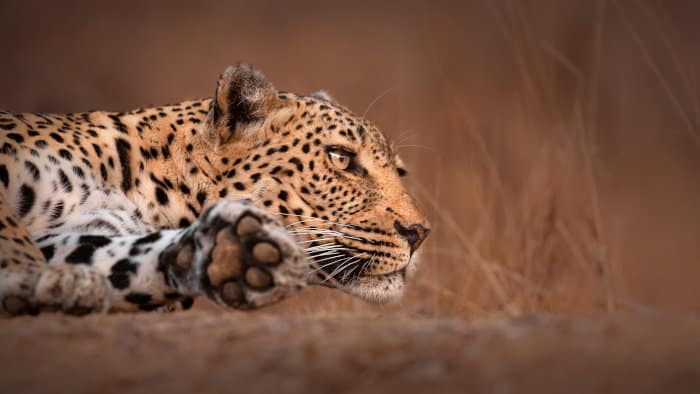
When you hear the term “cat eyes”, you probably think of vertical slit pupils.
That’s true for most of the smaller cat species, but big cats have round pupils just like humans.
Slit pupils are helpful for felines that are active during both day and night. They help them see in dim conditions yet prevent them getting blinded by strong sunlight. Slit pupils are also common in ambush predators, helping them judge distance.
Round pupils are linked to “active foragers” that chase prey, including wolves, tigers, and lions. Circular pupils give an even focus and help predators survey their surroundings.
Too tall for slit pupils
As ambush hunters, why do leopards have round pupils?
Slit pupils are more advantageous to cats that are closer to the ground.
Scientists discovered most predators with vertical pupils had shoulder heights under 42 cm. These predators often crouch down and pounce on prey from a stationary position.
Leopards are much taller and have a slightly different hunting method. While they don’t chase prey over large distances, leopards often make a brief charge before pouncing.
Round pupils also let plenty of light in while hunting at night.
Speaking of night vision…
4. Leopards Have Superb Night Vision
Leopard eyes are perfectly adapted to the big cat’s lifestyle as a nocturnal hunter. Stalking in the dark requires excellent night vision, and this gives leopards an advantage over their prey.
Their round pupils dilate to let more light in, just like our own eyes. Leopard eyes are much more effective, though – they can see seven times better in the dark than humans. Light receptor cells in their retina are more specialised for their nocturnal lifestyle.
What do leopards eat? That depends on habitat and prey availability. Leopards have a varied diet including everything from insects to large antelope.
5. Leopard Eyes Shine in the Dark

Many nocturnal animals have glowing eyes, and leopards are no exception. Apart from being a spooky sight, the big cat’s gleaming eyes are another adaptation to aid night vision.
Why do leopard eyes glow? It’s thanks to a reflective layer of tissue in the eye called the tapetum lucidum.
The tapetum lucidum lies behind the retina and reflects visible light back through the retinal cells. This increases the amount of light available to photoreceptors in the leopard’s eye.
It’s not just leopards – many nocturnal animals, including lions, have this adaptation.
6. Leopard Eye Disadvantages
The leopard’s adaptations aid nocturnal hunting, although they come with compromises.
Leopards’ round pupils constrict when there’s more light available, but not as effectively as the slit pupils of smaller cat species.
In the harsh light of day, it’s simply too bright for light-sensitive leopard eyes. This is why the big cat mainly spends daylight hours lounging in a tree or curled up in a shaded spot.
When leopards do try and hunt during the day, they’re far less successful. A 1974 study tracked radio-collared leopards in the Serengeti. Of 64 daytime hunts, just three ended in a kill.
7. Don’t Look a Leopard in the Eye
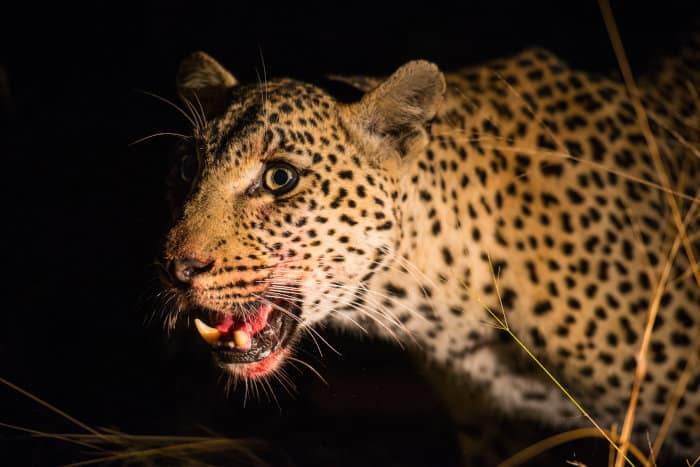
While it might be tempting to gaze into a leopard’s beautiful eyes, it’s a bad idea from a survival standpoint.
Why shouldn’t you look a leopard in the eye? It’s not just because staring is rude, but because you’ve blown its cover!
If you’re a good distance away in a safari vehicle, you should be safe, but if you’re on foot and close by, you should avoid the leopard’s gaze.
Leopards rely on camouflage, and they will often hunker down in the grass, hoping humans pass by unaware. If you look into a leopard’s eyes, it will know you’ve seen it and its “fight or flight” response will kick in.
Leopards rarely attack humans and would prefer to avoid potential injury, so they usually opt for “flight”. If the feline feels threatened, all bets are off.
8. Binocular Vision Benefits Predators
Like all cats, leopards have forward-facing eyes.
There’s a good reason why predators such as big cats have evolved binocular vision. This eye placement gives improved depth perception, allowing the animal to accurately tell how near or far away objects are.
Fine margins are often the difference between feasting or starving, so leopards need this precision during a hunt. Their peripheral vision isn’t as good, but that’s less important than locking onto their target.
Herbivores, however, have eyes on the side of their heads. This gives them a much wider field of view so they can scan the savanna for predators. Each eye sees something different, with only a small overlap at the front and a small blind spot behind.
It’s tough to sneak up on a herbivore, which is why leopards must rely on stealth, camouflage, and the cover of darkness.
9. Leopards Can Survive with One Eye
Injuries are often a death sentence to predators, so it might seem surprising that some leopards can survive with just one functional eye.
That’s one of the beauties of binocular vision. Sure, the leopard’s depth perception would suffer a little, but some resourceful cats can overcome this setback.
Indeed, leopards with a lost or damaged eye are sometimes seen, otherwise healthy and able to hunt.
A herbivore losing an eye, however, would be easy pickings for predators. With their monocular vision, prey species would lose almost half of their field of view.
10. Keeping an Eye on Other Predators
Leopards don’t just need to keep an eye on their prey. The big cat shares much of its habitat with other large carnivores, some of which pose a real threat.
Lions are big and strong enough to kill a leopard, and don’t react well to rival predators in their vicinity. Spotted hyenas are another of the feline’s main foes and boast a numbers advantage over the lonesome leopard.
Many clashes occur over food. Killing prey is only half the battle – finishing a meal is easier said than done when scavengers come sniffing.
This is where a leopard’s “tree-mendous” strength and climbing ability come in handy.
Leopards often haul prey up into a tree, so they can enjoy their meal in peace. A study in Sabi Sands Game Reserve found that leopards hoisted around half of their kills, weighing between 40% and 140% of their body mass.
This is an effective strategy against thieving lions and hyenas, but there’s one animal that can climb up – another leopard! Male leopards especially will gladly steal from females or juveniles.
Keep Your Eyes Peeled for Leopards on Safari
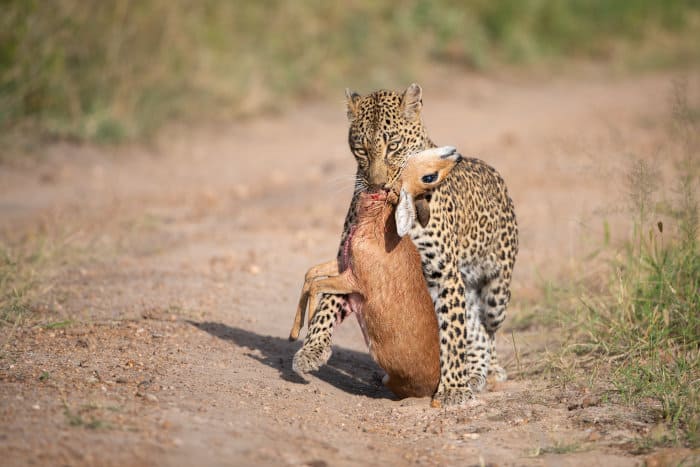
If you’re on safari in Africa, there’s a chance you’ll see a pair of leopard eyes for yourself. There’s no guarantee, of course, when dealing with one of the continent’s most elusive animals.
Perhaps the best chance of seeing a leopard during the daytime is coming across a carcass in a tree. Such a scene is the hallmark of this strong and agile cat, and most kills won’t remain unguarded for long.
Equally, you could come across this sleepy feline snoozing on a branch.
The best way to see this big cat at its most active may well be a night time game drive. When the sun sets, the African bush comes alive with a host of weird and wonderful creatures. Those shining orbs reflecting back at you may just be a pair of leopard eyes.


